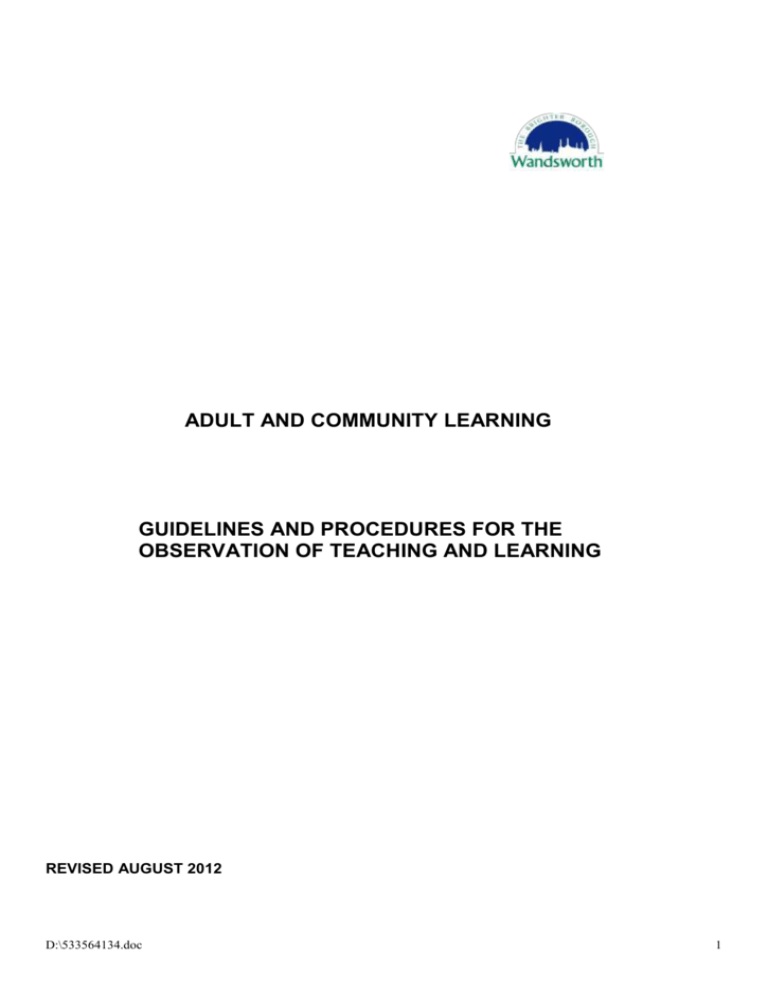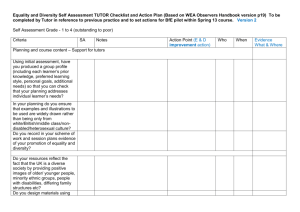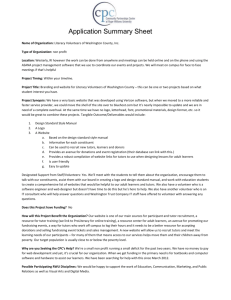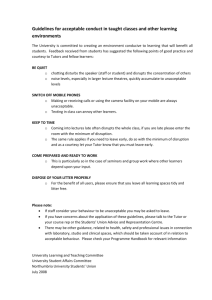Aim of Lesson Observation - Wandsworth Lifelong Learning
advertisement

ADULT AND COMMUNITY LEARNING GUIDELINES AND PROCEDURES FOR THE OBSERVATION OF TEACHING AND LEARNING REVISED AUGUST 2012 D:\533564134.doc 1 GUIDELINES Introduction The purpose of the procedures for the observation of teaching and learning is to promote consistency and openness about the OTL process. The process reflects the need to have a robust system to monitor effectiveness of teaching and learning across Wandsworth Lifelong Learning provision. At WLL the intention is that all tutors are visited in the classroom at least once during each academic year. In addition to classroom observations other quality monitoring (eg the quality of teaching and learning files [including individual learning plans] will take place at set times throughout the year. Aim of Lesson Observation The aim of lesson observation is to improve teaching and learning. Additionally the process provides observation grade profiles which are used to monitor the quality across providers and within areas of learning. The process is based on a culture of openness that supports, mentors and provides opportunities for tutors’ continuous development. The purpose of OTLs is: To monitor the quality of teaching and learning Develop and support tutors within teaching and learning. To raise the quality improvement of teaching and learning. Types of Observation Wandsworth Lifelong Learning has different types of observation processes: Formal lesson observation for assuring the quality of teaching and learning which result in an observation report and a grade awarded Short visit to confirm a previously awarded grade which results in completion of a short visit form Peer observation of teaching and learning for development purposes – these less formal observations are not part of this OTL process The type of observation undertaken will be determined by the category of the tutor as follows: Category of tutor Tutor new to the service Tutor receiving a grade 4 at last observation Tutor receiving a grade 3 at last observation Tutor receiving a grade 2 a last observation Tutor receiving a grade 1 at least observation Type of observation Full observation within 6 months of joining WCLL Full observation Full observation Observation confirmation visit Observation confirmation visit All tutors will have a graded observation once every two year observation schedule. However, certain circumstances may require tutors to be observed out of sequence, for example: Poor retention during a course Health and safety issues Complaints from learners Poor achievement of learners Concerns regarding equality D:\533564134.doc 2 Formal Observations The WCLL Curriculum and Quality Officer will be responsible for monitoring the quality of observations carried out by providers and the emphasis of observations will be on: Identifying the impact teaching is having on learning Identifying good practice in teaching that can then be shared across providers Encouraging tutors to self-evaluate their own practice Providing support and guidance for tutors and continuous professional development opportunities as appropriate Observations will be graded to provide evidence for quality assurance including the SelfAssessment Report following the grading scale used by OFSTED. As a result of the observation the observer will complete the Lesson Observation Record Form detailing the strengths, areas for development and agreed actions. All sessions observed must be graded using the 4 point evaluation scale as identified in the revised Common Inspection Framework Feedback to Tutors Where possible tutors should receive verbal feedback on the observation at the end of the session or, where this is impractical, within 48 hours. A copy of the Lesson Observation Record Form should be provided to the tutor within 10 working days of the observation. Ongoing support Providers are responsible for putting in place appropriate continuous professional development activities that meet the needs of their tutors. Where similar CPD needs are emerging across WCLL, centralised activities may be organised. Lesson Observer Competence Staff conductingg lesson observations must be competent. We expect observations to be carried out by staff with a nationally recognised teaching qualification and who have experience of delivering teaching. In community and voluntary organisations where they have no staff competent to underatke obsrvations, the Curriculum and Quality Officer will identify an appropriate member of the WCLL team to underatke their observations . PROCEDURE FOR THE OBSERVATION OF TEACHING AND LEARNING Graded Observations At least two weeks’ notice should be given to tutors indicating the session to be observed Notes of the observation should be kept confidential between the tutor, observer and WCLL manager/s. The observation of a group of learners should last at least 45 minutes. Observation of one to one sessions should be of shorter duration to reduce any stress caused to the learner– but should normally last at least 20 minutes. If it is not possible to observe the whole lesson, the observation should include its start or finish times. Before the observation The observer should: ensure the tutor has a copy of the Lesson Observation Guidelines which include the grading criteria ensure that, for courses of more than one session, the tutor has available at the session, their teaching and learning file which should contain all the items outlined in Appendix 1. for one-off sessions the tutor should make the lesson plan available. agree with the tutor when feedback will be given D:\533564134.doc 3 ask the tutor to alert learners to your presence and to reassure them that you are observing the session; make it clear that you will not be participating in the lesson. Thought should be given to where the observer will sit during the observation reassure the tutor that the observation will be as unobtrusive as possible but that you will take the opportunity to talk learners and see their work; ask the tutor at what point in the lesson this would be most appropriate clarify with the tutor anything on the lesson plans or scheme of work that is unclear gather any relevant information about learners, including identification of those with particular needs During the observation The observer should: constantly be asking the question, “Are learners learning effectively?” observe and note the tutor’s actions using the prompt questions on the form observe learners’ behaviour and make notes using the prompt questions on the form talk to learners about what and whether they are learning and their views of previous sessions look at learners’ work examine teaching and learning resources that are used record accurately observations made throughout the session that provide evidence against the key criteria check the number of learners on the register and attendance levels and pattern ask to see the tutor’s file GRADING Grade 1 – Outstanding: Grade 2 – Good Grade 3 – Requires improvement Grade 4 – Inadequate Please see Appendix 2 for further details on grading. After the observation The observer should: make judgements of strengths and areas for improvement based on the written observations made during the session in all sections of the Lesson Observation Record Form provide the tutor with immediate, constructive and sensitive feedback - in a private setting give feedback that is detailed with specific examples from the observation to support judgements give the tutor the opportunity to comment on the lesson and clarify any aspects discuss with the tutor areas for development and agree how these will be pursued. The tutor’s line manager will need to draw up an Action Plan with the tutor that identifies how strengths will be shared with other tutors and/or how areas for development will be addressed. Managers should make it clear to observers who in the organisation will need to agree the Action Plan and how it will be monitored establish grades for the observation and tell the tutor this – usually this is done at the end of the feedback give the tutor (and his/her manager) a copy of the Lesson Observation Record Form ideally immediately after the lesson but, if this is not practicable, not more than 5 days later if appropriate contact the WCLL Curriculum and Quality Manager for advice on on-going support for the tutor to address areas for development. If a tutor is unhappy with the feedback he/she should record this on Lesson Observation Record Form and his/her concerns should be discussed with the observer or where this is not appropriate with a manager within the organisation. D:\533564134.doc 4 Action Planning and Monitoring progress Line manager identifies, discusses and agrees Action Points with tutor. Tutors should be fully involved in this process and feel comfortable making their own suggestions as to how they can improve their performance. Action points should be specific and address the weaknesses identified. Agree and set milestones and completion dates for how, when and by whom each action point will be addressed. Agree dates and name the person responsible for monitoring and reviewing the Action Plan with the tutor on a regular basis. Grade Awarded at Observation Next Stage Grade 1 Development plan drawn up and actions monitored by line manager. This plan should include a target to share good practice. Short classroom visit within 12 months’ to ensure continuation of good practice Formal observation within 24 months. Grade 2 Development plan drawn up and actions monitored by line manager. Short classroom visit within 12 months’ to ensure grade at least maintained if not improved. Formal observation within 18 months. Grade 3 Development plan drawn up and actions monitored by line manager. Short classroom visit within 6 months. Formal observation within 12 months Grade 4 Intensive development plan drawn up. Development plan monitored fortnightly. Short classroom visit to observe progress in improvement of quality within 2 months. Formal re-observation with 4 months If remain at grade 4 subject specialist support put in place to work intensively with tutor. Further formal observation after 6 months. If grade remains at grade 4, then relevant capability procedures should be employed. D:\533564134.doc 5 MODERATION OF OBSERVATIONS OF TEACHING AND LEARNING Purpose Moderation of the Observation of Teaching and Learning process will take place with the purpose of: Ensuring a consistency in grades awarded Ensuring consistency in the quality of observation reports produced Identifying areas for continuous professional development activities Reports to be Moderated Moderation Panels, consisting of members of the Observation Team, will meet twice each academic year (January and June) and shall review: All sessions awarded Grade 1 All sessions awarded Grade 4 20% of all sessions awarded grade 2/3 Review and update of procedures The post-holder responsible for the development and review of the guidelines and procedure outlined below is the WCLL Curriculum and Quality Officer. MANAGING UNSATISFACTORY PERFORMANCE Teachers given a grade 4 for performance in a lesson observation will be supported to improve and monitored to ensure this is successful. However, if subsequent observations show no significant improvement in the teacher’s performance, the capability procedure for the organisation where the teacher is employed will be utilised. SHORT CLASSROOM VISITS For those tutors who received a grade 1 or 2 at their previous observation, a short observation confirmation visit to ensure consistency (or improvement) in grade will be undertaken. D:\533564134.doc 6 APPENDIX 1 TEACHING AND LEARNING - COURSE FILE CONTENTS Sections in Teaching and Learning File Comments and Supporting Documents Course/event information sheet Should show some details of the course so that this information can be used as initial information to recruit learners. Course information sheet document available. Scheme of work for the course The SOW is a living document that is likely to be altered as the course progresses. As the SOW is produced before course starts, the copy in the course file should be annotated to show any changes. Scheme of work document available. Initial assessment Give details of how the initial assessment process for this course was undertaken. Initial assessment should: Take account of learners' individual starting points - with the subject, with learning Ensure learners on right course - is the course compatible with their needs, aspirations, interests and career goals Identify any barriers to learning Identify any additional support requirements (copy of learning support request form available) Identification of preferred learning styles - introduce learners to their preferred styles and introducing them to strategies to support their styles Introduce health and safety issues (eg health issues assessed for fitness courses) (copy of physical activity questionnaire document available) Find out why learners on the course Find out what learners expect to get from the course Find out if there is anything that might prevent regular attendance (eg shift working, family commitments) Information gained from initial assessment will inform individual learning plans and also the group profile (documents available). Induction Tutors should follow the guidelines in the Induction Checklist (document available). For ACL provision, initial assessment is also undertaken as part of the induction process. This checklist is a guide and learners need to have this information early on in the course so that the learners are in a position to make the most of their learning The induction should also include some kind of icebreaker exercise so that learners feel easier with eachother and with the tutor. You should also agree a set of ground rules with the group – and this can also be a good opportunity to discuss the safeguarding agenda with the learners Induction checklist available D:\533564134.doc 7 Outline of the group Background information of each individual in the group including information about why they joined the course the, outcome of their initial assessment and any issues that may have an impact on their learning (eg may have problems attending regularly due to work commitments, English may not be their first language, they may have other support needs). This should be reviewed regularly throughout the length of the course as it may need to be added to as more knowledge of the learners is gained. Group Profile document available Session plans Session plans as they are produced It is vital to show how you meet the needs of learners in the session plan (ie differentiation) Should also have copy of any handouts or other resources used The evaluation section should be completed after each session and this should influence the contents of the subsequent session(s) Session plan document available. Student progress Individual Learning Plans and Group Tracking Grid Evidence of how students are progressing against the learning outcomes identified for the course and also their personal learning outcomes should be available in the course file. There should be an overall tracking grid for the group to give a quick picture of the progress of the group. The learners' ILPs should be in the teaching and learning course file - this way their contents can be used when planning sessions. The ILPs can be distributed to learners either at the start of each session or at regular planned points throughout the course . This will enable the tutor and learners to update the ILP regularly. Individual learning plan document available. Tracking grid document available. Progression Advice Evidence of advice given to learners on progression opportunities available Evidence that details of the National Careers Service are given to learners. https://nationalcareersservice.direct.gov.uk/Pages/Home.aspx Evaluation Evidence of evaluation of the course by the tutor and the learners Evaluation form available. D:\533564134.doc 8 APPENDIX 2 DESCRIPTORS FOR GOOD SESSIONS Observations report on three areas: learning and attainment teaching and training assessment, monitoring of progress and guidance and support for learners The following gives an indication of what you would expect to see in a good session: Learning and Attainment Learners attend regularly and are punctual. Learners contribute, work productively and make effective use of their time. Learners demonstrate good progress in acquiring knowledge, skills and understanding in line with objectives. Learners are interested, engaged and enjoying their learning/lesson. More able learners are challenged and stretched to meet their full potential. Less able learners are able to access learning. Learners achieve the learning outcomes. Learners demonstrate skills and understanding which reflect the level of the course and the duration of study. Learners are on track to achieve. Teaching and Training Intended learning outcomes are clear to learners. Lesson plan is consistent with scheme of work and is clear and comprehensive. Planning and delivery takes account of individual learning needs, including additional support if needed. Activities are varied, well managed and effective. Lesson has good pace and energy. Tutor’s instructions and explanations are clear. Teaching is challenging and inspiring. Assessment activities are linked to learning objectives. The learning of all learners is checked. Feedback helps learners to understand what they did well and what they need to do to improve. Learning aids and resources, including use of ILT are used effectively to promote learning. The learning environment is attractive and stimulating. Assessment, Monitoring of Progress & Guidance & Support for Learners Appropriate initial assessment has taken place and the outcomes recorded for each learner. An Individual Learning Plan is in place for each learner (this should show the outcome of initial assessment, have SMART course outcomes, personal outcomes and be reviewed regularly). Students understand how they are to be assessed and the purpose of the assessment. Assessment tasks are challenging but achievable. Learners are encouraged to self-assess and reflect on their learning. Learners have regular, appropriate feedback from tutor and these discussions are used to update Individual Learning Plans. Progression to further learning/employment features within planning materials/ILPs and lesson content. All learners are given the opportunity to evaluate the course and provide feedback on the learning experience. Tutors understand their responsibility with regards to safeguarding children and vulnerable adults. Grading of Sessions Sessions are given one of four grades: Grade 1 (outstanding), Grade 2 (good), Grade 3 (requires improvement) and Grade 4 (inadequate). Example grade descriptors: these are broad-stroke descriptions which do not contain every feature that might be considered within a lesson observation. Lessons will rarely contain ALL features as written in these descriptors and they should be used as general guidance only. Outstanding; learning activities are very well planned and paced with stimulating variety to motivate, include and engage all learners. Activities are sharply and accurately focused on meeting individual learners’ needs and promote very effective learning. Delivery is highly effective and sometimes inspirational. Learners are developing excellent skills, knowledge and understanding and are making significant and sometimes exceptional progress. Attendance is D:\533564134.doc 9 high and learner attitude and commitment to learning is outstanding. Activities promote equality and support diversity. Good: learning activities are well planned and paced with stimulating variety to motivate, include and engage all learners. Activities are well matched to learners’ different needs and promote productive, successful learning. Delivery is clear and effective. Learners are developing strong skills, knowledge and understanding and most are making significant progress. Attendance is high and learner attitude and commitment to learning is very good. Activities promote equality and support diversity. Requires improvement: learning activities are planned well with sufficient variety to engage all learners. Activities are mostly well matched to learners’ different needs and to promote successful learning. Delivery is clear and generally effective. Learners are developing skills, knowledge and understanding to a satisfactory level and most are making good progress. Attendance is good and learner attitude and commitment to learning is positive. Activities promote equality and support diversity. Inadequate: learning activities are not adequately planned and paced to motivate, include and engage all learners. Activities do not adequately meet the needs and interests of learners. Delivery is sometimes lacking in clarity and energy and does not always promote effective learning. Many learners are not making sufficient progress and/or levels expected as required for their next step in learning. Attendance is satisfactory or low and not all learners show a positive attitude and commitment to their learning. D:\533564134.doc 10







